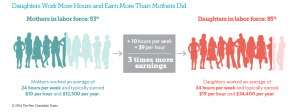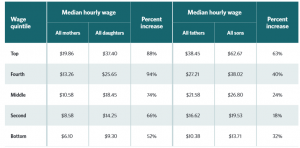
Today’s working woman probably makes three times what her mother did. But they don’t earn on par with their dads, or their brothers. So the male component retains the more frequent breadwinner status, with the female members of the families supplying supplemental income.
A study by the Pew Economic Mobility Project compared what women who were about age 40 earned in the late 1960s and early 1970s earned, in comparison with their daughters in the same age group in the 2000s.
“Increases in hours worked and wages translate into higher annual
earnings: Women today earn nearly three times what mothers did.”
The research showed that a higher percentage of women work today and they work longer hours at higher wages. Four times more women work outside the home now than did in the earlier time frame. Men’s jobs suffered more in the Great Recession, making women’s income more important to the family’s well-being.

At every income level, today’s women outstripped their mother’s earnings by at least 50 percent, the project learned. The wage differential between fathers and sons was lower, but the sons emerged as the group that leads in earnings.
Daughters have made big advances, but in comparison with their dads, are still at the bottom of the earnings ladder. Their per-hour income is less than Dad’s was thirty years ago, the study showed. Women leaving the workforce temporarily or permanently to be mothers accounts for some of the difference.
The Pew researchers, however, look ahead to trends that show the wage differences will continue to shrink. Women are graduating from college at higher rates now than men. The wages of the youngest women in the sampling are more on a parity with their male peers, assuring that their financial contributions to their families in the future will be even more important.